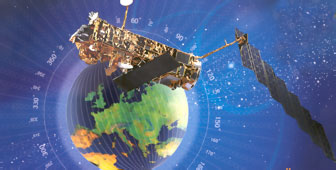Secrets of space laboratory revealed in Lucerne

A special exhibition on the largest Earth Observation Satellite ever built in Europe is taking place in Lucerne, ahead of its scheduled launch in October.
The environment satellite or Envisat weighs 8.2 kilograms and is the size of an articulated lorry. It has 10 instruments on board – more than any other satellite to date – and will monitor global change 24 hours a day, 365 days a year for at least the next five years.
The European Space Agency (ESA) says it has built Envisat to provide the long-term data needed by scientists for a better understanding of climate and environmental change.
“What is alarming is that humankind is depleting its renewable as well as its non-renewable resources very fast and that’s the reason to quantify those resources much better,” said Michael Rast, a scientist in ESA’s directorate for earth observation.
Map of the world
As Envisat circles the globe 14 times a day at a distance of 800 kilometres, information will be relayed to ground stations worldwide for analysis. The satellite will return in a 35-day cycle to the same orbit and after three days draw a complete map of the world.
Among other tasks, Envisat will monitor ocean levels, the ozone layer, the state of polar ice and plankton currents in the world’s seas.
“With its panoply of instruments, Envisat should give us a very good picture over a long time frame of the development of the forests, the state of the plankton which are responsible for carbon dioxide uptake in the oceans, and also the different trace gases in the atmosphere which contribute to the global warming effect,” said Rast.
“By tracing down to the centimetre the smallest changes to the Earth’s surface, it should help with the forecasting of natural catastrophes and disaster protection.”
ESA hopes that Envisat will deliver information that allows decision-makers to make
informed choices.
Reliable data should help protect the earth more effectively, said Dr Jean Pierre Ruder, head of section at the federal office for education and science, and a member of the Swiss delegation to ESA.
Shrinking rainforests
“The Envisat satellite will not solve any problems on its own but it gives all the necessary data politicians will need to decide if the well-being of the planet is really close to their hearts.
“Every hour, four square kilometres of rainforest disappear around the world. This is proven with earth observation data. It cannot be denied by anybody. Politicians will have to take responsibility and decide how to act to ascertain the survival of mankind on this planet.”
The latest figures show that the world’s population has increased tenfold over the last 300 years and currently stands at six billion and 54 million. Experts predict that by 2050 the population level will have increased by 50 per cent to nine billion.
In the last 100 years, 50 per cent of global forests have been destroyed; and average temperatures have increased by 0.3°C since the 1960s. Carbon dioxide concentration is at its highest level in 20 million years. The United Nations Intergovernmental Panel on Climate Change expects average temperatures to rise by up to 6°C within the century.
Understanding is crucial
The scientists admit it is a risk packing so much technology into one satellite but say it is essential to have a comprehensive understanding of the environment and climatic processes.
“It is very difficult to see interactions in the climate between land, ocean and atmosphere with smaller satellites,” said Rast. “They fly at different times and they observe different spots.
“You have to observe atmosphere, ocean and land contemporaneously to really understand what sort of processes are happening in our environment. Only when we’ve understood the processes can we make reasonably accurate predictions and assumptions about our climate development.”
An Ariane-5 rocket is due to launch Envisat from the European Spaceport in French Guyana on October 12. Envisat has cost 2.3 billion Euros to develop.
The exhibition, which is taking place at the Swiss Museum of Transport and Communication in Lucerne, includes a scale model of Envisat. It will be displayed in Zurich in October as well as other cities in Germany and Austria.
by Vincent Landon

In compliance with the JTI standards
More: SWI swissinfo.ch certified by the Journalism Trust Initiative
You can find an overview of ongoing debates with our journalists here . Please join us!
If you want to start a conversation about a topic raised in this article or want to report factual errors, email us at english@swissinfo.ch.